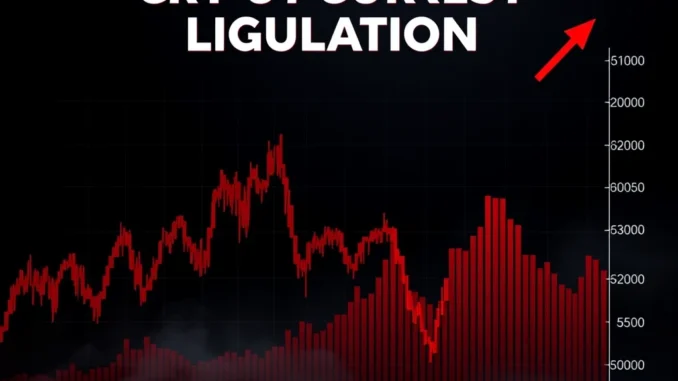
Hold onto your hats, crypto traders! The market has just experienced a dramatic hour of turbulence, with a staggering $110 million worth of futures positions liquidated across major exchanges. If you thought that was intense, brace yourselves – the past 24 hours have seen a jaw-dropping $841 million vanish in liquidations. What does this mean for you, and what’s causing this whirlwind of volatility in the crypto space? Let’s dive deep into the heart of these crypto liquidations and uncover the key factors at play.
Understanding Crypto Liquidations: What Just Happened?
In the fast-paced world of cryptocurrency trading, especially with leveraged products like futures, liquidations are a critical event. But what exactly are futures liquidations, and why are they causing such a stir right now?
- Leverage is Key: Futures trading allows you to control a large position with a relatively small amount of capital, using leverage. This can amplify both profits and losses.
- Margin Calls and Liquidation: To maintain a leveraged position, you need to hold a certain amount of margin in your account. If the market moves against your position and your margin falls below a critical level (the liquidation price), the exchange will automatically close your position to prevent further losses. This is a liquidation.
- Domino Effect: When a large number of traders are on the wrong side of a trade, especially with high leverage, a cascade of liquidations can occur. As prices drop, more positions are liquidated, further driving down prices and triggering even more liquidations. This can lead to rapid and significant market movements, like the one we’re witnessing now.

Why Are We Seeing Such High Futures Liquidation Numbers?
The current surge in futures liquidation volume points towards heightened market volatility and potential shifts in market sentiment. Several factors could be contributing to this:
- Sudden Price Swings: The cryptocurrency market is known for its volatility. Unexpected news, regulatory announcements, or even large whale movements can trigger rapid price fluctuations.
- Overleveraged Positions: Many traders, especially in a bull market, tend to use high leverage to maximize potential gains. However, this also dramatically increases their risk of liquidation during market downturns.
- Market Correction: After periods of significant price appreciation, markets often undergo corrections. These corrections can be sharp and swift, catching overleveraged traders off guard and leading to mass liquidations.
- External Economic Factors: Global economic events, inflation data, interest rate hikes, and geopolitical tensions can all impact the cryptocurrency market and contribute to volatility.
Impact of Bitcoin Futures and Ethereum Futures Liquidations
Bitcoin futures and Ethereum futures are the two dominant cryptocurrency futures contracts. Liquidations in these markets have a ripple effect across the entire crypto ecosystem.
| Impact Area | Bitcoin Futures Liquidation | Ethereum Futures Liquidation |
|---|---|---|
| Market Sentiment | Can trigger fear and uncertainty in the broader Bitcoin market, potentially leading to further selling pressure. | Impacts Ethereum’s price and sentiment, affecting the DeFi ecosystem and projects built on Ethereum. |
| Price Action | Significant Bitcoin liquidations can lead to sharp drops in Bitcoin’s price, impacting all other cryptocurrencies. | Large Ethereum liquidations can cause Ethereum’s price to plummet, affecting altcoins and the overall market. |
| Trader Confidence | Erosion of confidence in Bitcoin’s short-term price stability, potentially leading to traders reducing risk exposure. | Reduced confidence in Ethereum’s immediate price prospects, potentially causing traders to re-evaluate their ETH holdings. |
Navigating Market Volatility: Actionable Insights for Crypto Traders
In times of high market volatility and increased crypto liquidations, it’s crucial to trade responsibly and manage risk effectively. Here are some actionable insights:
- Reduce Leverage: Consider lowering your leverage, especially during periods of uncertainty. Lower leverage reduces your liquidation risk significantly.
- Use Stop-Loss Orders: Always use stop-loss orders to limit potential losses. A stop-loss order automatically closes your position if the price reaches a predetermined level.
- Diversify Your Portfolio: Don’t put all your eggs in one basket. Diversify your crypto holdings to spread risk.
- Stay Informed: Keep abreast of market news and analysis. Understanding market trends and potential catalysts for volatility can help you make more informed trading decisions.
- Trade with Caution: During periods of high volatility, consider reducing your trading frequency or trading smaller position sizes.
- Long-Term Perspective: Remember that cryptocurrency markets are cyclical. Focus on the long-term potential of your investments rather than getting caught up in short-term price swings.
Conclusion: Riding the Crypto Waves
The recent surge in crypto liquidations serves as a stark reminder of the inherent volatility and risks in the cryptocurrency market. While these events can be unsettling, they also present opportunities for informed and disciplined traders. By understanding the dynamics of futures liquidation, managing risk effectively, and staying adaptable, you can navigate these turbulent waters and position yourself for long-term success in the exciting world of crypto. Stay vigilant, trade smart, and remember that in the crypto market, volatility is often the price of admission to potentially extraordinary gains.



